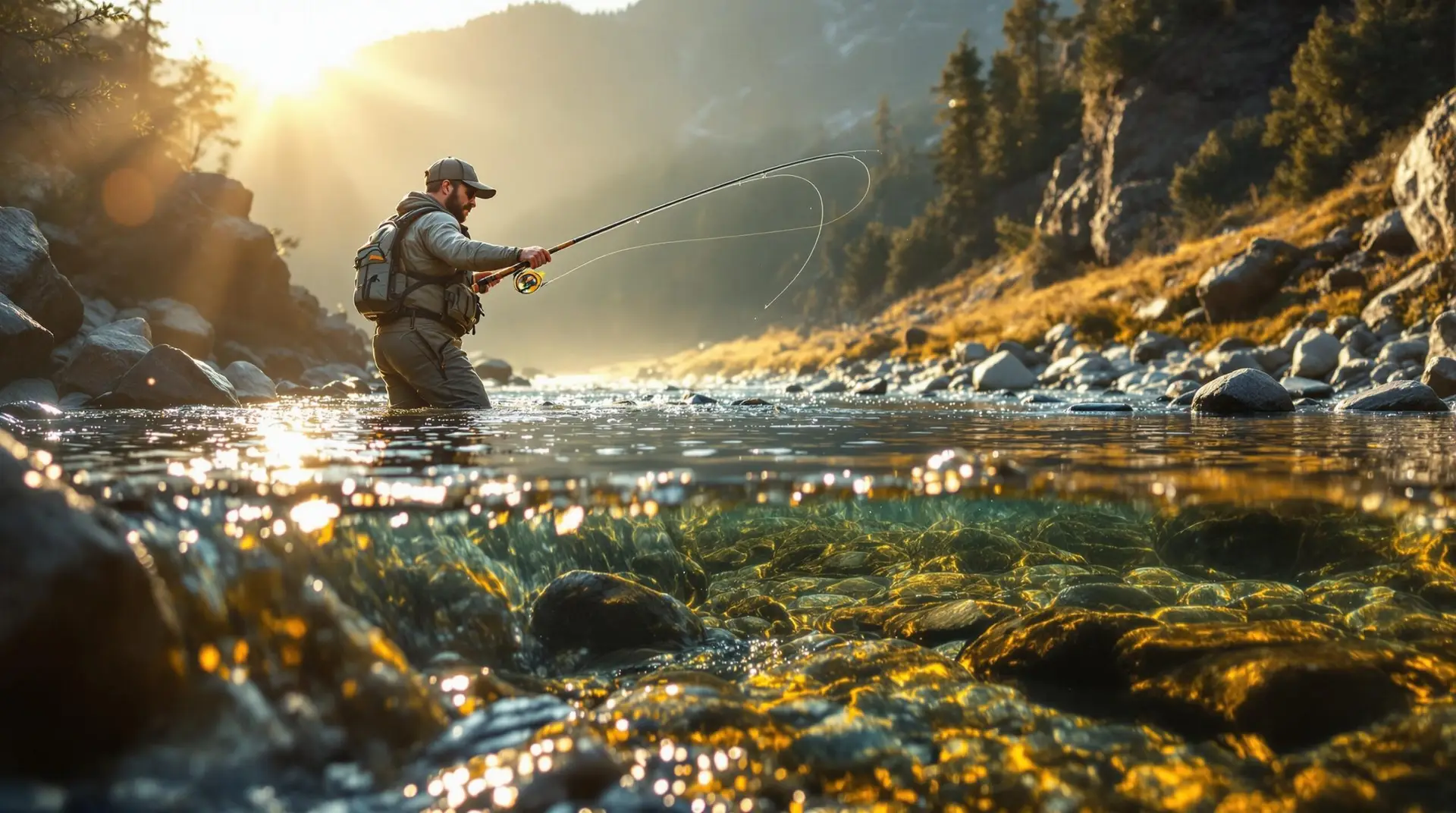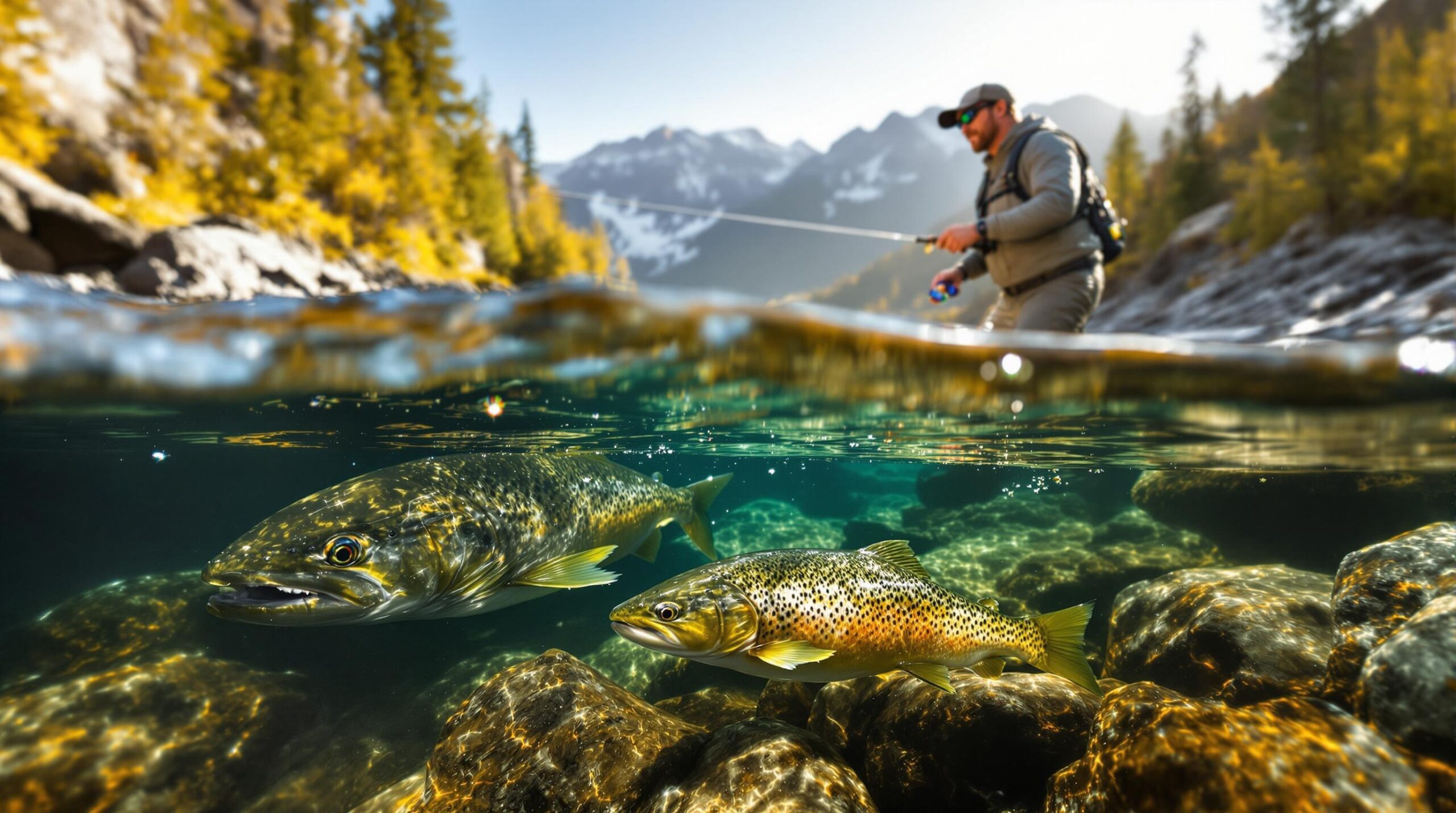According to a study in Fisheries Research, anglers practicing technical nymph fishing techniques experience up to 60% higher catch rates compared to traditional methods when targeting trout in clear, flowing waters. Technical nymph fishing represents the perfect intersection of science and art, combining precise water reading skills with drift mechanics to consistently fool even the most selective trout.
Key Takeaways
- Current seams are the primary targets for successful technical nymph fishing
- Maintaining a drag-free drift is essential for natural presentation in technical nymph fishing
- The ability to identify trout holding positions dramatically increases catch rates
- Using tungsten beaded nymphs allows precise depth control in various water types
- Mastering indicator-less techniques increases sensitivity to subtle takes in technical nymph fishing
Understanding Technical Nymph Fishing Fundamentals
Technical nymph fishing differs from traditional fly fishing methods by emphasizing precise presentation in challenging conditions. This approach focuses on specialized techniques that allow anglers to detect subtle strikes and maintain natural drifts in varying currents.
The core of technical nymph fishing involves using weighted flies that sink quickly to the strike zone where trout feed most actively. Reading water effectively is the foundation of successful nymphing, as it allows anglers to identify high-percentage holding areas.
European nymphing techniques have revolutionized technical nymph fishing, with methods like Czech, French, and Spanish nymphing providing solutions for different water conditions. According to research published in the New Zealand Journal of Marine and Freshwater Research, these approaches can increase catch rates by up to 40% over traditional indicators.
Modern technical nymph fishing setups typically include longer rods (10-11 feet), thin diameter leaders, and specialized fly patterns designed to penetrate the water column efficiently. This combination allows for better drift control and strike detection in technical nymph fishing scenarios.
Reading Water for Technical Nymph Fishing Success
The foundation of technical nymph fishing lies in understanding how to read moving water. Water reading focuses on identifying subsurface structures, current seams, and depth variations where trout are likely to hold.
Current seams represent the borderline between fast and slow-moving water, creating prime feeding zones for trout. In technical nymph fishing, these seams provide oxygen-rich environments where fish can hold while expending minimal energy.
Pocket water offers multiple small holding areas that are perfect targets for technical nymph fishing approaches. These protected zones behind rocks create micro-current systems where trout can rest while having access to food drifting downstream.
The depth of your nymphs determines their effectiveness in technical nymph fishing scenarios. According to the Journal of Freshwater Ecology, 80% of trout feeding activity occurs within 12 inches of the riverbed, making bottom presentation crucial.
When practicing technical nymph fishing, pay special attention to transition zones between fast and slow currents. These areas concentrate food and provide strategic holding positions for feeding trout.
Nymph Fishing Tackle and Equipment
Specialized equipment enhances the effectiveness of technical nymph fishing approaches. Longer rods (10-11 feet) provide better line control and drift management in varying currents.
Leaders for technical nymph fishing typically feature thin diameters and extended lengths, often 12-15 feet. This configuration allows for more natural presentations and increased sensitivity to subtle takes.
Tungsten beaded nymphs are essential for technical nymph fishing because they sink quickly and maintain depth effectively. Their dense weight-to-size ratio allows for smaller profiles that trigger more strikes from selective trout.
Tippet selection for technical nymph fishing balances visibility concerns with strength requirements. Fluorocarbon materials offer advantages in clarity and sink rate, making them preferred for technical presentations.
Strike detection tools vary in technical nymph fishing, from traditional strike indicators to colored monofilament sighters built into specialized leader systems. Each approach offers benefits depending on water conditions and drift mechanics.
Advanced Technical Nymph Fishing Techniques
Euro-nymphing represents the cutting edge of technical nymph fishing development. This approach eliminates traditional strike indicators in favor of direct line contact with the flies, dramatically increasing sensitivity.
Technical nymph fishing often employs multiple fly rigs to cover different depths simultaneously. According to a study by the American Angling Association, two-fly rigs can increase catch rates by 35% compared to single fly presentations.
The high-stick technique is fundamental to technical nymph fishing success. This approach keeps excess line off the water, reducing drag and allowing for more natural drifts through complex current patterns.
Micro-adjustments in leader length, tippet diameter, and fly weight form the core of technical nymph fishing adaptations. These subtle modifications allow anglers to match presentations precisely to changing water conditions.
Technical nymph fishing requires mastering the “feel” of the drift. Developing tactile sensitivity to detect subtle takes and drift disruptions separates expert practitioners from novices in this approach.
Key Trout Holding Locations for Nymph Fishing
Understanding trout holding patterns is essential for technical nymph fishing success. Trout position themselves strategically to maximize feeding opportunities while minimizing energy expenditure.
Seam lines between currents create prime technical nymph fishing opportunities. These areas concentrate food and provide comfortable holding water for actively feeding trout.
Tailouts of pools offer excellent technical nymph fishing potential, especially during insect hatches. These shallow, oxygenated areas often hold actively feeding fish that respond well to dead-drifted nymphs.
Structure elements like submerged logs, boulders, and cutbanks create prime targets for technical nymph fishing. These features provide cover and create current breaks where trout can hold comfortably.
Understanding depth dynamics is crucial for technical nymph fishing. Trout typically hold at specific depths based on water temperature, food availability, and oxygen levels, with most feeding activity occurring near the river bottom.
Drift Mechanics in Technical Nymph Fishing
The concept of drag-free drift defines successful technical nymph fishing. Achieving natural movement requires eliminating surface drag influences that transmit to subsurface flies.
Mending techniques are essential skills in technical nymph fishing. Strategic line placement above the water creates slack that compensates for different current speeds affecting the drift.
Technical nymph fishing requires understanding how subsurface currents differ from surface patterns. Bottom flows often move at different speeds and directions, requiring adaptations in presentation.
Tracking the drift path visually helps optimize technical nymph fishing presentations. Mental mapping of underwater structure allows anglers to anticipate drift patterns and adjust presentations accordingly.
Strike detection in technical nymph fishing involves integrating visual and tactile cues. Successful anglers develop heightened sensitivity to subtle line movements, hesitations, and irregular drift patterns that signal takes.
Seasonal Adaptations for Nymph Fishing
Technical nymph fishing requires seasonal adjustments to match changing trout behavior. Spring approaches focus on higher water levels and targeting pre-spawn fish in transitional holding areas.
Summer technical nymph fishing adapts to warmer water temperatures and lower flows. Targeting oxygenated riffles and spring seeps becomes crucial as trout seek cooler, oxygen-rich environments.
Fall technical nymph fishing coincides with spawning behaviors for brown and brook trout. Ethical anglers focus on feeding fish rather than targeting spawning redds during this sensitive period.
Winter demands significant modifications to technical nymph fishing approaches. Slower presentations, reduced fly sizes, and targeting deep, slow pools where lethargic trout conserve energy become essential strategies.
Water temperature dramatically influences technical nymph fishing success throughout the year. Research from the American Fisheries Society indicates that feeding activity peaks within specific temperature ranges, typically between 55-65°F for most trout species.
Common Nymph Fishing Mistakes to Avoid
Excessive line on the water represents the most common technical nymph fishing error. Minimizing surface line prevents unwanted drag that disrupts natural drift patterns.
Many anglers fail at technical nymph fishing by fishing too shallow. Research shows that matching the precise depth where trout are holding is often more important than fly pattern selection.
Impatience undermines technical nymph fishing success. Covering water too quickly prevents thorough exploration of promising holding areas where multiple drifts may be necessary to trigger strikes.
Poor line management creates missed opportunities in technical nymph fishing. Maintaining direct contact with flies while eliminating slack is essential for detecting subtle takes from selective trout.
Many anglers neglect adapting to changing conditions during technical nymph fishing sessions. Successful practitioners continuously adjust depth, weight, and presentation based on ongoing observations and results.
Mastering Technical Nymph Fishing Through Practice
Developing technical nymph fishing expertise requires deliberate practice focused on specific skills. Breaking down the approach into component techniques allows for targeted improvement in each area.
Recording observations during technical nymph fishing sessions accelerates learning. Noting water conditions, successful patterns, and effective presentations creates valuable reference data for future outings.
Seeking mentorship from experienced technical nymph fishing practitioners provides shortcuts to proficiency. Learning directly from skilled anglers transfers knowledge that might take years to develop independently.
Analyzing failures objectively improves technical nymph fishing performance more quickly than celebrating successes. Understanding why presentations were rejected leads to refinements in approach and technique.
Consistency in technical nymph fishing comes from developing a systematic approach to water analysis and presentation. Creating a repeatable process for reading water and selecting appropriate techniques builds confidence and reliability.
What is the main difference between technical nymph fishing and traditional fly fishing?
Technical nymph fishing focuses on precise subsurface presentations using weighted flies, specialized leaders, and sophisticated drift management techniques. Unlike traditional fly fishing, it emphasizes direct contact with flies, often eliminates strike indicators, and requires longer rods (10-11 feet) for better line control in varying currents.
How do I choose the right weight for my nymphs in nymph fishing?
Select nymph weight based on water depth, current speed, and desired drift depth. Start with heavier tungsten beads in faster/deeper water and lighter options in shallow runs. The ideal weight allows your flies to reach the bottom third of the water column quickly without excessive bouncing. Adjust incrementally until your drift achieves the perfect balance.
What leader setup works best for nymph fishing?
Optimal technical nymph fishing leaders feature extended length (12-15 feet), thin diameter, and progressive taper designs. For Euro-nymphing, use specialized leaders with colored monofilament sighters. Include 4-5X fluorocarbon tippet for clear water and selective trout. The perfect setup balances sensitivity for strike detection with strength for handling larger fish.
How can I improve my ability to read water for nymph fishing?
Develop water reading skills by studying current seams, identifying subsurface structure, and observing where bubbles slow or stop (indicating depth changes). Practice visualizing underwater topography and current patterns. Focus on recognizing prime trout holding areas like transition zones, pocket water, and tailouts. Consider using polarized glasses to enhance visibility.
What’s the best rod action for nymph fishing?
Medium-fast to medium action rods perform best for technical nymph fishing. This action profile provides sufficient sensitivity to detect subtle takes while maintaining enough backbone to control fish. Look for specialized “Euro-nymphing” rods with soft tips for strike detection and stronger mid-sections for line control. Longer lengths (10-11 feet) help manage drifts across multiple currents.
How do I achieve a drag-free drift in technical nymph fishing?
Create drag-free drifts by minimizing surface line, employing strategic mends to counteract current differences, and maintaining a high rod position. Use reach casts to position line properly before your flies touch water. Continuously adjust line tension to eliminate slack without creating drag. Focus on keeping your leader and tippet moving at the same speed as the current.
Sources:
Drake Magazine. (2021). Interview with Lance Egan.
Fly Fisherman. (2021). Mastering the Euro-nymph.
MidCurrent. (2019). Interview with Devin Olsen.
Orvis. (2018). The Orvis Guide to Prospecting for Trout: New and Revised.
Orvis. (2020). Interview with George Daniel.
SmithFly. (2021). The Complete Guide to Nymph Fishing.
Trout Unlimited. (2020). Nymphing Techniques for Every Situation.


